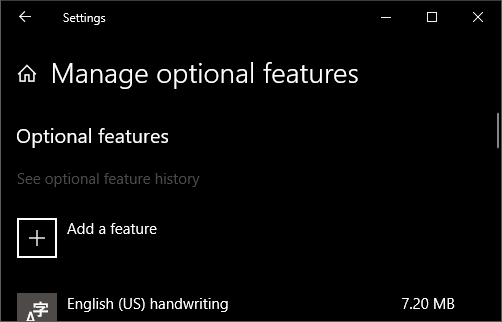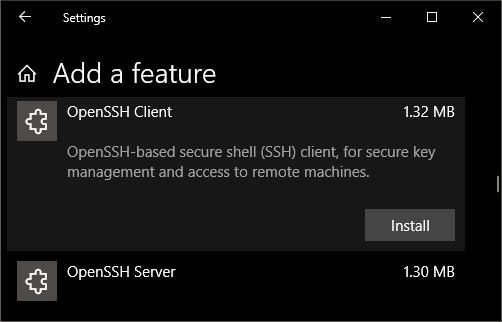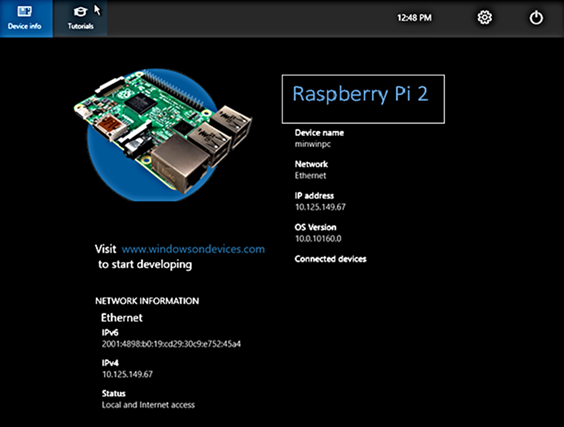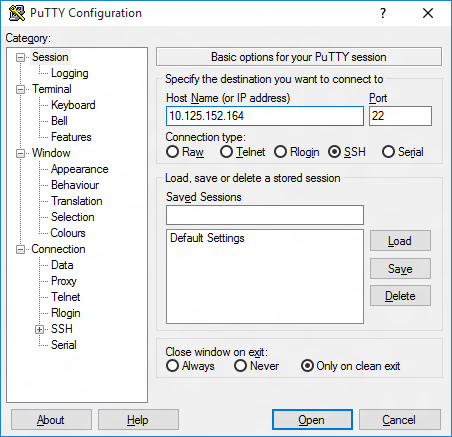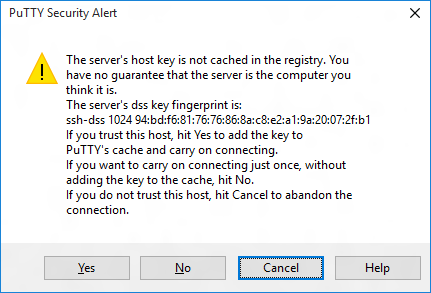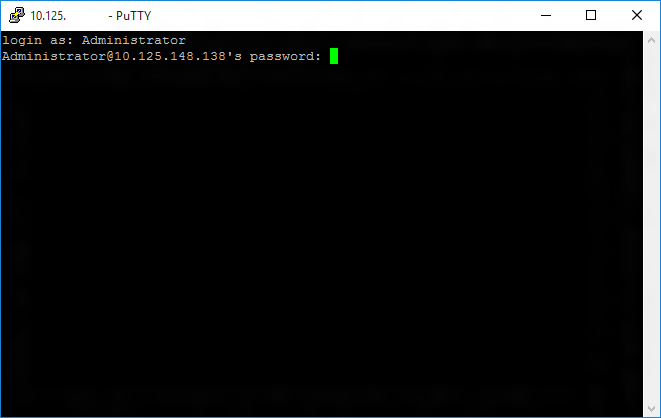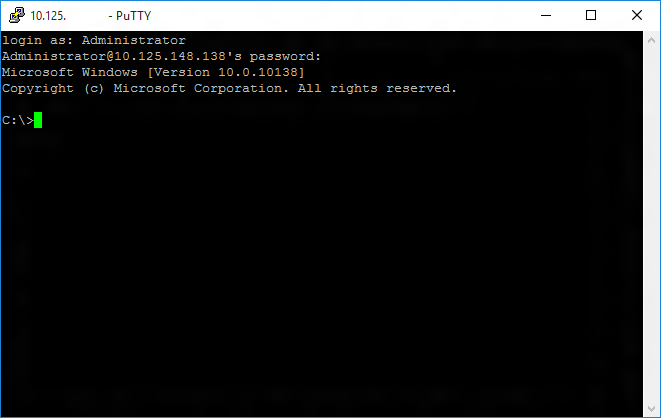- Безопасная оболочка (SSH) Secure Shell (SSH)
- Использование клиента Windows 10 OpenSSH Using the Windows 10 OpenSSH client
- Использование выводимых Using PuTTY
- Скачивание SSH-клиента Download an SSH client
- Подключение к устройству Connect to your device
- Обновление пароля учетной записи Update account password
- Настройка устройства Windows IoT базовая Configure your Windows IoT Core device
- Часто используемые служебные программы Commonly used utilities
- OpenSSH Server Configuration for Windows 10 1809 and Server 2019
- Configuring the default shell for OpenSSH in Windows
- Windows Configurations in sshd_config
- AllowGroups, AllowUsers, DenyGroups, DenyUsers
- AuthenticationMethods
- AuthorizedKeysFile
- ChrootDirectory (Support added in v7.7.0.0)
- HostKey
- Match
- PermitRootLogin
- SyslogFacility
- Not supported
Безопасная оболочка (SSH) Secure Shell (SSH)
Secure Shell (SSH) позволяет удаленно администрировать и настраивать устройство Windows IoT базовая. Secure Shell (SSH) allows you to remotely administer and configure your Windows IoT Core device
Использование клиента Windows 10 OpenSSH Using the Windows 10 OpenSSH client
Клиент Windows OpenSSH требует, чтобы ОС узла SSH-клиента была Windows 10 версии 1803 (17134). The Windows OpenSSH client requires that your SSH client host OS is Windows 10 version 1803(17134). Кроме того, устройство Windows 10 IoT базовая должно работать под RS5 предварительной версии Windows Предварительная версия 17723 или более поздней. Also, the Windows 10 IoT Core device must be running RS5 Windows Insider Preview release 17723 or greater.
Клиент OpenSSH был добавлен в Windows 10 в 1803 (сборка 17134) как дополнительный компонент. The OpenSSH Client was added to Windows 10 in 1803 (build 17134) as an optional feature. Чтобы установить клиент, можно выполнить поиск по запросу Управление дополнительными компонентами в параметрах Windows 10. To install the client, you can search for Manage Optional Features in Windows 10 settings. Если клиент OpenSSH не указан в списке установленных компонентов, выберите Добавить компонент. If the OpenSSH Client is not listed in the list of installed features, then choose Add a feature.
Затем выберите в списке клиент OpenSSH и нажмите кнопку установить. Next select OpenSSH Client in the list and click Install.
Чтобы войти с помощью имени пользователя и пароля, используйте следующую команду: To login with a username and password use the following command:
Где Host — это IP-адрес устройства Windows IoT базовая или имя устройства. Where host is either the IP address of the Windows IoT Core device or the device name.
При первом подключении появится сообщение следующего вида: The first time you connect you see a message like the following:
Введите Да и нажмите клавишу Ввод. Type yes and press enter.
Если необходимо войти как Дефаултаккаунт, а не как администратор, потребуется создать ключ и использовать его для входа. If you need to login as DefaultAccount rather than as administrator, you will need to generate a key and use the key to login. На рабочем столе, с которого планируется подключиться к устройству IoT, откройте окно PowerShell и перейдите в папку личных данных (например, CD
). From the desktop that you intend to connect to your IoT Device from, open a PowerShell window and change to your personal data folder (e.g cd
Зарегистрируйте ключ с помощью ssh-агента (необязательно, для интерфейса единого входа). Register the key with ssh-agent (optional, for single sign-on experience). Обратите внимание, что SSH-Add необходимо выполнять из папки, которая является ACL, в качестве пользователя, выполнившего вход в систему (Builtin \ администраторы NT_AUTHORITY \system также ОК). Note that ssh-add must be performed from a folder that is ACL’d to you as the signed-in user (Builtin\Administrators and the NT_AUTHORITY\System user are also ok). По умолчанию компакт-диск
из PowerShell должен быть достаточно, как показано ниже. By default cd
from PowerShell should be sufficient as shown below.
Если вы получаете сообщение о том, что служба ssh-agent отключена, ее можно включить с помощью sc.exe config ssh-agent Start = Auto . If you receive a message that the ssh-agent service is disabled you can enable it with sc.exe config ssh-agent start=auto
Чтобы включить единый вход, добавьте открытый ключ в файл authorized_keys устройства Windows IOT базовая. To enable single sign, append the public key to the Windows IoT Core device authorized_keys file. Если у вас есть только один ключ, скопируйте файл открытого ключа в файл удаленного authorized_keys . Or if you only have one key you copy the public key file to the remote authorized_keys file.
Если ключ не зарегистрирован в ssh-agent, он должен быть указан в командной строке для входа: If the key is not registered with ssh-agent, it must be specified on the command line to login:
Если закрытый ключ зарегистрирован в ssh-agent, необходимо указать только DefaultAccount@host : If the private key is registered with ssh-agent, then you only need to specify DefaultAccount@host:
При первом подключении появится сообщение следующего вида: The first time you connect you see a message like the following:
Введите Да и нажмите клавишу Ввод. Type yes and press enter.
Теперь вы должны подключиться как дефаултаккаунт You should now be connected as DefaultAccount
Чтобы использовать единый вход с учетной записью администратора , добавьте открытый ключ в к:\дата\програмдата\сш\ administrators_authorized_keys на устройстве Windows IOT базовая. To use single sign-on with the administrator account, append your public key to c:\data\ProgramData\ssh\administrators_authorized_keys on the Windows IoT Core device.
Кроме того, необходимо задать список ACL для administrators_authorized_keys в соответствии с ACL ssh_host_dsa_key в том же каталоге. You will also need to set the ACL for administrators_authorized_keys to match the ACL of ssh_host_dsa_key in the same directory.
Настройка ACL с помощью PowerShell To set the ACL using PowerShell
Если вы видите сообщение об изменении идентификатора удаленного узла после внесения изменений в устройство Windows 10 IOT базовая, измените C:\Users . SSH \ known_hosts и удалите узел, который был изменен. If you see a REMOTE HOST IDENTIFICATION CHANGED message after making changes to the Windows 10 IoT Core device, then edit C:\Users .ssh\known_hosts and remove the host that has changed.
Использование выводимых Using PuTTY
Скачивание SSH-клиента Download an SSH client
Чтобы подключиться к устройству с помощью SSH, сначала необходимо скачать клиент SSH, например, выполнив. In order to connect to your device using SSH, you’ll first need to download an SSH client, such as PuTTY.
Подключение к устройству Connect to your device
Чтобы подключиться к устройству, сначала необходимо получить IP-адрес устройства. In order to connect to your device, you need to first get the IP address of the device. После загрузки устройства Windows IoT базовая на экране, подключенном к устройству, будет отображаться IP-адрес: After booting your Windows IoT Core device, an IP address will be shown on the screen attached to the device:
Теперь запустите выводимый текст и введите IP-адрес в Host Name текстовое поле и убедитесь, что SSH выбран переключатель. Now launch PuTTY and enter the IP address in the Host Name text box and make sure the SSH radio button is selected. Затем нажмите кнопку Open . Then click Open .
Если вы подключаетесь к устройству в первый раз с компьютера, вы можете увидеть следующее оповещение системы безопасности. If you’re connecting to your device for the first time from your computer, you may see the following security alert. Просто щелкните Yes , чтобы продолжить. Just click Yes to continue.
Если соединение прошло успешно, login as: на экране появится запрос на вход. If the connection was successful, you should see login as: on the screen, prompting you to login.
Введите Administrator и нажмите клавишу ВВОД. Enter Administrator and press enter. Затем введите пароль по умолчанию в p@ssw0rd качестве пароля и нажмите клавишу ВВОД. Then enter the default password p@ssw0rd as the password and press enter.
Если вы смогли успешно войти в систему, вы увидите нечто вроде: If you were able to login successfully, you should see something like this:
Обновление пароля учетной записи Update account password
Настоятельно рекомендуется обновить пароль по умолчанию для учетной записи администратора. It is highly recommended that you update the default password for the Administrator account.
Для этого введите следующую команду в консоли выводимых команд, заменив [new password] строгим паролем: To do this, enter the following command in the PuTTY console, replacing [new password] with a strong password:
Настройка устройства Windows IoT базовая Configure your Windows IoT Core device
Чтобы иметь возможность развертывать приложения из Visual Studio 2017, необходимо убедиться, что Удаленный отладчик Visual Studio работает на устройстве Windows IoT базовая. To be able to deploy applications from Visual Studio 2017, you will need to make sure the Visual Studio Remote Debugger is running on your Windows IoT Core device. Удаленный отладчик должен запускаться автоматически во время загрузки компьютера. The remote debugger should launch automatically at machine boot time. Чтобы дважды проверить, используйте команду TList, чтобы вывести список всех запущенных процессов из PowerShell. To double check, use the tlist command to list all the running processes from PowerShell. На устройстве должно быть открыто два экземпляра msvsmon.exe. There should be two instances of msvsmon.exe running on the device.
Время ожидания Удаленный отладчик Visual Studio может истекает после длительных периодов бездействия. It is possible for the Visual Studio Remote Debugger to time out after long periods of inactivity. Если Visual Studio не удается подключиться к устройству Windows IoT Core, попробуйте перезагрузить устройство. If Visual Studio cannot connect to your Windows IoT Core device, try rebooting the device.
При необходимости можно также переименовать устройство. If you want, you can also rename your device. Чтобы изменить имя компьютера, используйте setcomputername программу: To change the ‘computer name’, use the setcomputername utility:
Чтобы изменения вступили в силу, необходимо перезагрузить устройство. You will need to reboot the device for the change to take effect. Команду можно использовать shutdown следующим образом: You can use the shutdown command as follows:
Часто используемые служебные программы Commonly used utilities
Список команд и служебных программ, которые можно использовать с SSH, см. на странице служебной программы командной строки . See the Command Line Utils page for a list of commands and utilities you can use with SSH.
OpenSSH Server Configuration for Windows 10 1809 and Server 2019
This topic covers the Windows-specific configuration for OpenSSH Server (sshd).
OpenSSH maintains detailed documentation for configuration options online at OpenSSH.com, which is not duplicated in this documentation set.
Configuring the default shell for OpenSSH in Windows
The default command shell provides the experience a user sees when connecting to the server using SSH. The initial default Windows is the Windows Command shell (cmd.exe). Windows also includes PowerShell and Bash, and third party command shells are also available for Windows and may be configured as the default shell for a server.
To set the default command shell, first confirm that the OpenSSH installation folder is on the system path. For Windows, the default installation folder is SystemDrive:WindowsDirectory\System32\openssh. The following commands shows the current path setting, and add the default OpenSSH installation folder to it.
| Command shell | Command to use |
|---|---|
| Command | path |
| PowerShell | $env:path |
Configuring the default ssh shell is done in the Windows registry by adding the full path to the shell executable to Computer\HKEY_LOCAL_MACHINE\SOFTWARE\OpenSSH in the string value DefaultShell.
As an example, the following Powershell command sets the default shell to be PowerShell.exe:
Windows Configurations in sshd_config
In Windows, sshd reads configuration data from %programdata%\ssh\sshd_config by default, or a different configuration file may be specified by launching sshd.exe with the -f parameter. If the file is absent, sshd generates one with the default configuration when the service is started.
The elements listed below provide Windows-specific configuration possible through entries in sshd_config. There are other configuration settings possible in that are not listed here, as they are covered in detail in the online Win32 OpenSSH documentation.
AllowGroups, AllowUsers, DenyGroups, DenyUsers
Controlling which users and groups can connect to the server is done using the AllowGroups, AllowUsers, DenyGroups and DenyUsers directives. The allow/deny directives are processed in the following order: DenyUsers, AllowUsers, DenyGroups, and finally AllowGroups. All account names must be specified in lower case. See PATTERNS in ssh_config for more information on patterns for wildcards.
When configuring user/group based rules with a domain user or group, use the following format: user?domain* . Windows allows multiple of formats for specifying domain principals, but many conflict with standard Linux patterns. For that reason, * is added to cover FQDNs. Also, this approach uses «?», instead of @, to avoid conflicts with the username@host format.
Work group users/groups and internet-connected accounts are always resolved to their local account name (no domain part, similar to standard Unix names). Domain users and groups are strictly resolved to NameSamCompatible format — domain_short_name\user_name. All user/group based configuration rules need to adhere to this format.
Examples for domain users and groups
Examples for local users and groups
AuthenticationMethods
For Windows OpenSSH, the only available authentication methods are «password» and «publickey».
AuthorizedKeysFile
The default is «.ssh/authorized_keys .ssh/authorized_keys2». If the path is not absolute, it is taken relative to user’s home directory (or profile image path). Ex. c:\users\user. Note that if the user belongs to the administrator group, %programdata%/ssh/administrators_authorized_keys is used instead.
ChrootDirectory (Support added in v7.7.0.0)
This directive is only supported with sftp sessions. A remote session into cmd.exe wouldn’t honor this. To setup a sftp-only chroot server, set ForceCommand to internal-sftp. You may also set up scp with chroot, by implementing a custom shell that would only allow scp and sftp.
HostKey
The defaults are %programdata%/ssh/ssh_host_ecdsa_key, %programdata%/ssh/ssh_host_ed25519_key, %programdata%/ssh/ssh_host_dsa_key, and %programdata%/ssh/ssh_host_rsa_key. If the defaults are not present, sshd automatically generates these on a service start.
Match
Note that pattern rules in this section. User and group names should be in lower case.
PermitRootLogin
Not applicable in Windows. To prevent administrator login, use Administrators with DenyGroups directive.
SyslogFacility
If you need file based logging, use LOCAL0. Logs are generated under %programdata%\ssh\logs. For any other value, including the default value, AUTH directs logging to ETW. For more info, see Logging Facilities in Windows.
Not supported
The following configuration options are not available in the OpenSSH version that ships in Windows Server 2019 and Windows 10 1809:
- AcceptEnv
- AllowStreamLocalForwarding
- AuthorizedKeysCommand
- AuthorizedKeysCommandUser
- AuthorizedPrincipalsCommand
- AuthorizedPrincipalsCommandUser
- Compression
- ExposeAuthInfo
- GSSAPIAuthentication
- GSSAPICleanupCredentials
- GSSAPIStrictAcceptorCheck
- HostbasedAcceptedKeyTypes
- HostbasedAuthentication
- HostbasedUsesNameFromPacketOnly
- IgnoreRhosts
- IgnoreUserKnownHosts
- KbdInteractiveAuthentication
- KerberosAuthentication
- KerberosGetAFSToken
- KerberosOrLocalPasswd
- KerberosTicketCleanup
- PermitTunnel
- PermitUserEnvironment
- PermitUserRC
- PidFile
- PrintLastLog
- RDomain
- StreamLocalBindMask
- StreamLocalBindUnlink
- StrictModes
- X11DisplayOffset
- X11Forwarding
- X11UseLocalhost
- XAuthLocation
—>
